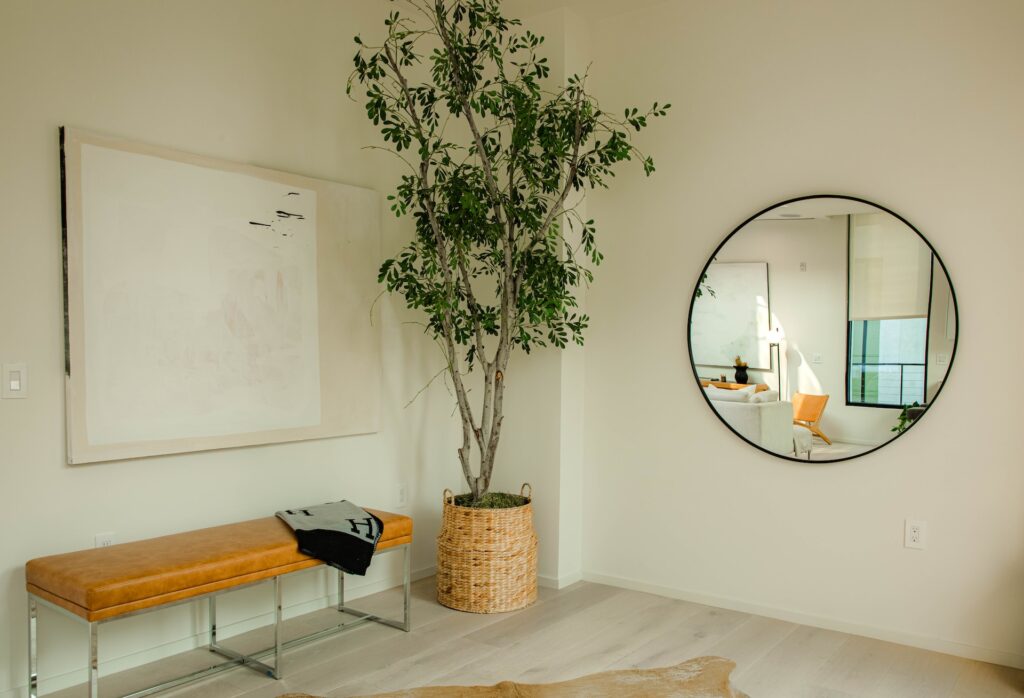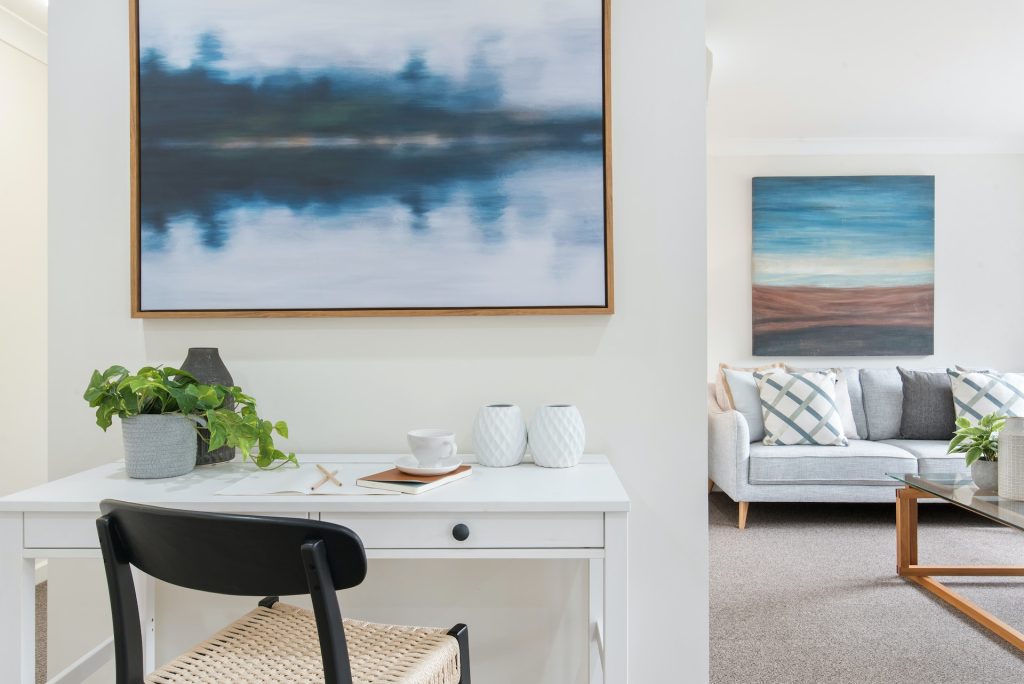If you’re looking for boldness and glamour, look no further than the art deco interior design style. This trend from the 1920s is still making waves today, with its geometric shapes and luxurious materials that combine to make a truly striking statement in any room.
Whether used as an accent or embraced throughout your home décor scheme, incorporating art deco elements can transform a space into something unique. In this guide, we’ll explore what makes this classic trend so timeless and show you some of our favourite elements to bring out of the past into your modern home!
The Origins of Art Deco Style
Art Deco, a distinct style characterized by bold geometrics and modern materials, has returned in recent years. Originating between WWI and WWII, its history is rooted in the luxurious Parisian salons of the late 19th century. Designers back then sought to create elegant artworks inspired by classical antiquity and cutting-edge technological advancements simultaneously.
As this trend progressed into the 20th century, artists began to embrace strong colours and geometric shapes to characterise their creations. From furniture to jewellery to architecture – art deco was everywhere during this golden age of design. Since then, it has continued to inspire creators across a wide spectrum of mediums and cultures.
The Key Features of Art Deco Interior Design
Art Deco Interior Design is a classic style of design that began in the 1920s and still captivates people with its artful glamour today. Its approach typically incorporates rich, bold colours with sharp geometry. You’ll often find geometric shapes, metallic tones, strong lines, polished materials and symmetrical patterns in many Art Deco interiors. Attention to detail is also important in this design style as it celebrates luxurious materials such as velvet, marble or glass.
Art Deco interiors blend acrylics or sleek metals with rare woodgrain finishes to create visually stimulating spaces. The function finds a place in these designs as light fixtures are contoured to masterfully cast shadows and reflections around the space. Art Deco Interior Design can transform any room from dull and lifeless to inviting and stylish.
The Use of Geometric Shapes
Art Deco interior design is renowned for using geometric shapes and bold lines to create a luxurious look. One of the distinguishing features of Art Deco is the use of geometric shapes, such as sharp angles, concentric circles and rectilinear designs, to enhance the beauty of a room. These geometrical shapes focus on the intended feature or area while creating an air of sophistication and elegance.
For example, a round dining table with angular legs creates a sense of balance in its space, while using squares and rectangles in furniture and accessories creates visual interest and movement. By combining elements from different geometric shapes and playing with various angles, Art Deco designers achieved stunning results that have remained timeless for decades.
Bold and Dramatic Colour Palettes
Art Deco-style interiors are often characterized by bold, dramatic colour palettes that balance deep, jewel-like tones with lighter, airy shades. It is possible to create an immense range of looks by carefully selecting materials and shades. A good example of this can be seen in Art Deco interior design where lighter doors and floors are matched with complementary dark colours such as plum, teal or navy to create incredibly glamorous and eye-catching spaces. This is further enhanced when luxurious finishes such as metallic details or opulent chandeliers are added to rooms filled with jewel-toned velvets, mosaics and wallpapers to establish a strong visual interest.
Use of Metals and Mirrors
Art Deco interior design featured metal details and mirrored surfaces to add a chic, modern flair to homes. The look blended elements of Art Nouveau and Cubism with influences from Ancient Egypt and Mesoamerican cultures to create a striking take on modern luxury. Further, metals such as bronze, brass and chrome were often combined with walnut veneers, satinwood and exotic woods like zebra wood to warm the clean lines of Art Deco interiors.

Meanwhile, etched mirrors offered a glamorous layer to many rooms, reflecting light off walls and making smaller spaces seem larger. This combination of materials allowed for a unique blend of contemporary elements with touches from Ancient art styles for an unmistakable aesthetic that remains in high demand.
Luxurious Fabrics and Textures
Art Deco interior design showcases sophisticated indulgence using luxurious fabrics and textures. Intricate detailing and bold colours are two consistent characteristics found throughout the design. For example, Art Deco draperies often feature opulent fabrics, like velvet and silk damask, adding an ornamental touch to the room.
Luxurious fur-textured rugs present an opulent layer beneath classic furniture pieces, emphasising this interior design style’s rich themes and atmosphere. To complete the look, intricate marble embellishments grace tables, counters and bannisters, giving everything an air of grandeur and distinction. This is why one cannot help but feel lavishness inside a room designed with this aesthetic in mind.
The Role of Lighting in Art Deco Design
Interior lighting was a crucial aspect of Art Deco interior design. Lighting designers built upon the popular decorative geometric motifs, taking inspiration from the bright colours and chevron designs used in later movements such as Cubism.
Specialized lighting fixtures, such as rectangular or cone-shaped wall sconces, allowed homeowners to create light patterns against walls and surfaces while embracing the minimalistic style. These pieces contained high-quality materials like chrome, glass, porcelain, and lacquered finishes that could be viewed day or night for an added dose of drama to the interior space. With its stylistic presence and innovative engineering, the lighting had a lasting effect on early 20th-century Deco interiors and remains essential to their elegant aesthetic today.
Furniture and Accessories for Art Deco Style
The furniture and accessories you incorporate into your home design are integral to the Art Deco style. Look for items with ornate designs and dramatic geometric shapes featuring many different types of materials, such as chrome, lacquer, inlaid wood and glass. Accessorize the room with art objects such as sculptures, lamps, or a mirror that provide a frame for displaying artwork.
Remember that these sculptural pieces will bring energy and vibrancy to any Art Deco interior, so don’t be afraid to go all out! You can even find furniture pieces embellished with bold colours and highly decorative elements like zigzag patterns or chevron stripes to complete a truly unique look.
Art Deco Architecture
Art Deco architecture was a popular design in the 1920s, and it has been described as a distinct style that blends traditional craftsmanship with modern materials. Characterised by vertical solid lines and kaleidoscopic patterns, the movement sought to bring a sense of optimism to a world still reeling from the Great War. From skyscrapers like The Chrysler Building in Manhattan to luxury hotels along Los Angeles’ Wilshire Boulevard, Art Deco architecture added an element of flair and flamboyance to cities worldwide. Its lasting influence on design makes Art Deco architecture one of the most celebrated styles from the 20th century.
Applying Art Deco Style in Your Home
Art Deco style has a significant resurgence in home design; the signature colours, bold patterns and mesmerizing symmetry of this 20th-century movement are popping up everywhere. To be successful when using Art Deco in your own house, it’s essential to think beyond small accents and create a consistent theme that plays through each room.

Details like graphic wallpapers, geometrical lighting fixtures, lush fabrics and symmetrical-themed furniture can help unify the look and bring a touch of modern sensibility to any house. For those looking for an even bolder statement, try making art deco part of your daily routine by adding luxurious materials such as chrome or chrome-plated items onto lamp stands, glass tables or other home decor accessories.
Art Deco-Inspired DIY Projects
Unleash your inner creative and try your hand at some fun, creative Art Deco-inspired DIY projects! Art Deco was such an influential movement in the early 20th century, and incorporating it into a handmade project can be fun and educational. Whether you prefer crafting something meant to be added as an aesthetic touch to your home or want to create stand-out wall art, DIYing your Art Deco-inspired project could be the perfect way to show off your unique style. All you need are some crafty supplies, some inspiration (which you can find online or in vintage shops!), and a few hours of dedicated time. Ready, set, craft!
Conclusion
Art Deco style is a design classic for the ages. With its signature materials, bold colours and angular shapes, Art Deco captures the marvels of modernity and brings them into our homes. Whether it’s sleek furniture pieces or statement lighting fixtures, Art Deco-inspired home decor can be an eye-catching way to bring a touch of drama and sophistication to any space. And with the help of some DIY projects, you can incorporate this timeless style into your home decor in an affordable way! It’s time to get inspired and start creating!








